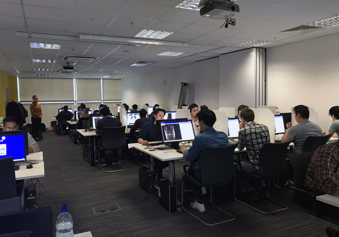DDMFR Part A - scoring system
LEARN MOREThe DDMFR Part A Examination consists of two modules:
- Module 1 - Anatomy: written paper component and image viewing component
- Module 2 - Radiological Sciences and Techniques: written paper component
To achieve a pass at DDMFR Part A candidates must pass both modules. If a candidate passes one module of the two at a given sitting, they can retain the passed module and need only resit the
failed module.
Module 1 - Anatomy
Anatomy consists of a written question paper and an image viewing component. Each component is independently marked (see below). In order the pass this module, both components must be passed. Failure in one component cannot be offset by good performance in the other and there is no option to retain a ‘pass’ in just one component.
The written paper component
The written question paper comprises four short notes questions on Anatomy. The papers are marked by examiners using the system below:
| Candidate Response | Mark |
|---|---|
| No answer offered | 3 |
| Fail: Weak, incomplete, or inadequate answer. Significant errors / omissions made | 4 |
| Borderline: Demonstrates some understanding/knowledge, but answer incomplete with some errors/omissions or of insufficient detail | 5 |
| Pass: Demonstrates satisfactory understanding/knowledge with adequate coverage and detail. | 6 |
| Good Pass: Good answer that includes additional points to the ‘pass grade’ answer. | 7 |
| Excellent: A perfect answer, clear and accurate | 8 |
To pass the written paper of the Anatomy module, the candidate must score an average mark of 6 across all questions.
The image viewing component
This component comprises 100 questions and is automatically marked by the platform, which is programmed with acceptable anatomy answers. The answers will be matched with candidate responses and marks awarded by the system accordingly. Any answers that do not exactly match those within the platform will be reviewed by the examiners and awarded an appropriate mark. Anatomy examiners will review all responses prior to results awarding.
The marking system shown below is used:
| For each item answered with complete accuracy | +2 marks |
| For each item answered with less accuracy, but still correct | +1 mark |
| For each item answered incorrectly | 0 mark |
A ‘modified’ Angoff method is used to set the pass mark for this modular component. This involves a panel of subject matter experts (examiners) evaluating each question and providing an estimate as to how likely the just-passing candidate would know the answer. Each item is scored on the basis of the percentage of ‘just passing’ candidates who should know the correct answer. These scores are collated and presented at the standard setting meeting, with particular attention and review given to any items where there is a wide variance in examiner scoring. After discussion, the standard setters again score the questions, and the mean of the post-discussion scores is used to set the standard.
Module 2: Radiological Sciences and Techniques
This module consists of a written paper component only. The paper comprises six short notes/structured essay questions. The written examination papers are marked by participating examiners using the scoring system below:
| Candidate Response | Mark |
|---|---|
| No answer offered | 3 |
| Fail: Weak, incomplete, or inadequate answer. Significant errors / omissions made | 4 |
| Borderline: Demonstrates some understanding/knowledge, but answer incomplete with some errors/omissions or of insufficient detail | 5 |
| Pass: Demonstrates satisfactory understanding/knowledge with adequate coverage and detail. | 6 |
| Good Pass: Good answer that includes additional points to the ‘pass grade’ answer. | 7 |
| Excellent: A perfect answer, clear and accurate | 8 |
To pass Module 2 (Radiological Sciences and Techniques), the candidate must score an average mark of 6 across all questions in the written paper.
Our exams
Find out more about our FRCR exams in clinical radiology and clinical oncology, and DDMFR exams in dental and maxillofacial radiology.
